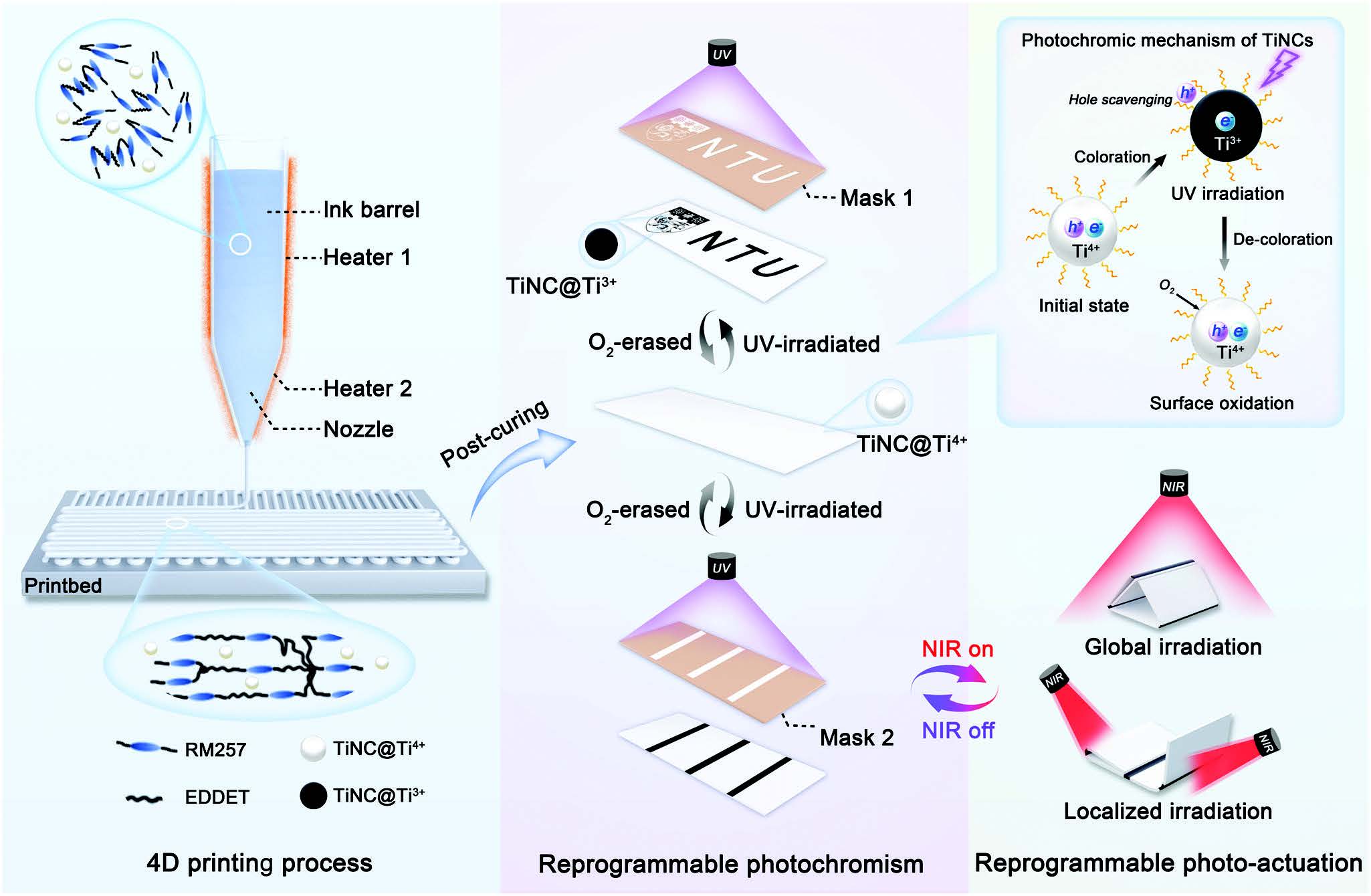| Oct 03, 2023 | |
Shining a light on 4D printed liquid crystals switches colors and transforms shapes |
|
| (Nanowerk Spotlight) Smart materials that can change their properties like color or shape in response to external stimuli are highly desirable for advanced applications like soft robotics, adaptable optics, and camouflage. Liquid crystal elastomers (LCEs) are particularly promising smart materials due to their ability to undergo large, fast, and reversible shape changes when exposed to stimuli like heat, light or chemicals. | |
| Liquid crystals are materials that exhibit properties between conventional liquids and solid crystals. Some molecules in liquid crystals naturally align in a certain orientation when in a liquid state. Liquid crystal elastomers are rubbery materials made by linking liquid crystal molecules together into polymer networks. The aligned liquid crystal regions give them unique mechanical properties. | |
| In their relaxed state, the elongated liquid crystal molecules in LCEs point along a particular direction. When exposed to stimuli like heat, light or chemicals, the liquid crystal regions become disordered, and the molecules lose their alignment. This molecular disorder causes the macroscopic shape of the LCE to change significantly and rapidly, like contracting along the original liquid crystal alignment direction. | |
| The alignments in LCEs can be "programmed" during manufacturing by controlling conditions to set the orientation of the liquid crystals. This enables LCE materials and objects made from them to be designed to deform in specific ways when triggered by a stimulus. So, a thin LCE strip programmed to align its liquid crystals lengthwise will bend when heated, while a sheet programmed with crystals re-aligning across its width and length will contract in both dimensions. | |
| The ability to pre-define commands and repeatedly trigger large, fast and controlled shape changes with simple stimuli like light makes LCEs attractive smart materials. Their soft, flexible and elastic nature also allows them to be used for biomimetic applications like artificial muscles and soft robots. However, most LCEs rely solely on thermal stimulation and have fixed configurations, limiting their adaptability. | |
| Now, researchers from Nanyang Technological University (NTU) in Singapore have developed and 3D printed LCEs with reprogrammable photochromism and synergistic photoactuation, allowing for remote and precise control over both the color and shape change. | |
 |
|
| Schematic representation of 4D-printed reprogrammable titanium-based nanocrystal (TiNC)/liquid crystal elastomer composite for tunable photochromism and photoactuation. The figure illustrates the 4D printing process (left), the photochromic mechanism of the TiNCs (top right), and the reprogrammable photochromism and photoactuation properties of the printed composite (center and right). (Reprinted with permission by Wiley-VCH Verlag) (click on image to enlarge) | |
| The team published their findings in Advanced Materials ("4D Printing of Reprogrammable Liquid Crystal Elastomers with Synergistic Photochromism and Photoactuation"). | |
| 3D printing with the direct ink writing (DIW) technique allows programming of the molecular alignment in LCEs. This is achieved by precisely controlling the printing path to set the orientation of the liquid crystal regions. In this way, 3D printing enables fabrication of LCE objects with pre-designed stimuli-responsive shape-changing abilities. | |
| However, most printed LCEs still depend only on thermal actuation. To achieve light-driven color change and shape morphing, the NTU researchers incorporated titanium-based nanocrystals (TiNCs) into the LCEs. The TiNCs exhibit reversible photochromism, rapidly switching between white and black colors upon ultraviolet (UV) and visible light irradiation, due to redox reactions of the titanium species. In the UV-induced black state, the TiNCs can efficiently convert near-infrared (NIR) light into heat, providing photothermal actuation of the LCEs. | |
| By optimizing the 3D printing process, the researchers formulated a TiNC/LCE composite ink and printed a variety of objects like strips, sheets and 3D lattice structures. The printed objects could be pre-programmed to undergo specific shape changes like bending, twisting or snapping when heated above a threshold. | |
| More interestingly, exposure to UV light triggered rapid color switching from white to black, while subsequent NIR irradiation induced photothermal actuation only in the UV-irradiated black regions. This enabled functionalities like a photodriven robotic gripper that could repeatedly grasp, move and release objects on light command. | |
| Through precise spatial control over the light exposure, the researchers were able to pattern the printed LCEs with reprogrammable color images, text and barcodes via masked UV irradiation. The UV-patterned objects would then exhibit selectively actuated regions and shapes when irradiated with NIR light. | |
| Remarkably, origami and kirigami-inspired shapes like light-driven blooming flowers, curled sheets and ladders with tunable rung spacing could be realized by erasing and reprogramming the color patterning and photoactuation. | |
| This new reprogrammable LCE material provides a flexible platform to design adaptive structures and devices with dual color change and shape morphing abilities. The remote light-control and wide design freedom could enable soft robots that can reconfigure themselves for different tasks as well as camouflage or encryption applications. With further development, the multifunctional printed LCEs may find use in areas like bioinspired robotics, dynamic optical components, multilevel information storage and reconfigurable electronics. | |
 By
Michael
Berger
– Michael is author of three books by the Royal Society of Chemistry:
Nano-Society: Pushing the Boundaries of Technology,
Nanotechnology: The Future is Tiny, and
Nanoengineering: The Skills and Tools Making Technology Invisible
Copyright ©
Nanowerk LLC
By
Michael
Berger
– Michael is author of three books by the Royal Society of Chemistry:
Nano-Society: Pushing the Boundaries of Technology,
Nanotechnology: The Future is Tiny, and
Nanoengineering: The Skills and Tools Making Technology Invisible
Copyright ©
Nanowerk LLC
|
|
|
Become a Spotlight guest author! Join our large and growing group of guest contributors. Have you just published a scientific paper or have other exciting developments to share with the nanotechnology community? Here is how to publish on nanowerk.com. |
|
